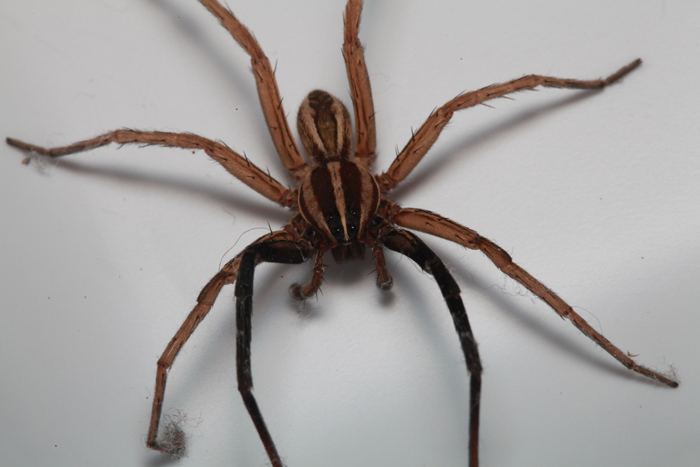I was reminded the other day of the old saying “You’re never more than five feet from a spider”. I was working on the computer when I glanced up from my keyboard to look into the face of a BIG wolf spider. It was sitting on the base of my computer monitor about 2 feet away.
After the initial startle reaction (even entomologists are human) I had to smile. I really do like spiders–if not especially on my keyboard–and I was thinking how most of my non-entomologist friends would react to such a close encounter with a wolf spider.
Wolf spiders are very common around homes, even in our supposedly sterile manicured Texas lawns. One year I did a little experiment in my back yard and poured a bucket full of soapy water on a couple of square feet (this is a common method used to flush insects hiding in turf). By far the most common thing to come crawling to the tips of the grass were wolf spiders, over a dozen. It was a good reminder that even relatively simple ecosystems like lawns have an impressive amount of biological activity. It also explains why wolf spiders are one of the most common spiders submitted to my office for identification… it’s only a short jog from the lawn to that little crack under the house door.
Wolf spiders are hunting spiders. This means they don’t sit passively on their web, but go out and search for food. Unlike their namesakes, they don’t necessarily chase down prey, but go to a likely location and wait for a tasty insect or other small arthropod to come along. When things get slow, they pick up and move to a new location. According Richard Bradley’s Common Spiders of North America, there are at least 238 different species of wolf spiders in America north of Mexico. They can be found in just about any habitat, from the beach tidal zones to the highest mountaintops. Most wolf spiders are nocturnal, coming out at night to hunt.
One thing I didn’t know about wolf spiders, till reading Bradley’s book was that they use silk draglines to keep in touch with other wolf spiders. When wolf spiders wander, they lay down these silk lines. When a male spider encounters the line of female, he may follow it to find her (the original pick-up line?).
This time of year, in mid summer, female wolf spiders may frequently be seen carrying egg sacs, and eventually brood, on their backs. This type of parental care allows the female to regulate temperatures for the eggs and young, and gives an added degree of protection during their young lives.
A great activity to do with kids (or just for yourself) is to go out in the lawn (or even better, an unmowed field) at night with a flashlight. Put the flashlight up next to your face and shine it in the grass or weeds. It normally doesn’t take long to notice little sets of reflective eyes shining back at you. Chances are these are wolf spiders. The main pair of eyes on wolf spiders face forward and are large enough to reflect light that can be seen by human eyes. If you have a cup and a credit card you can usually catch these spiders and admire them before releasing them back to their natural haunts.
After having its picture taken, my spider ended up being transported to the green lawn outside my office. I encourage you to do the same the next time you see a big wolf spider indoors. It won’t be able to hear your screams anyway.
